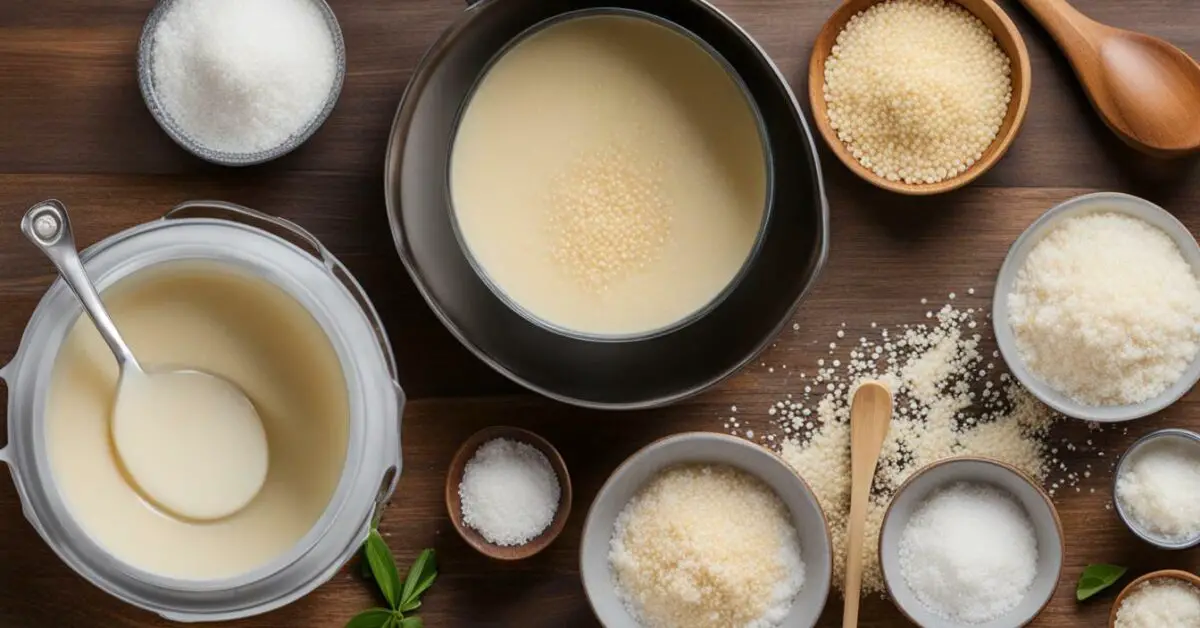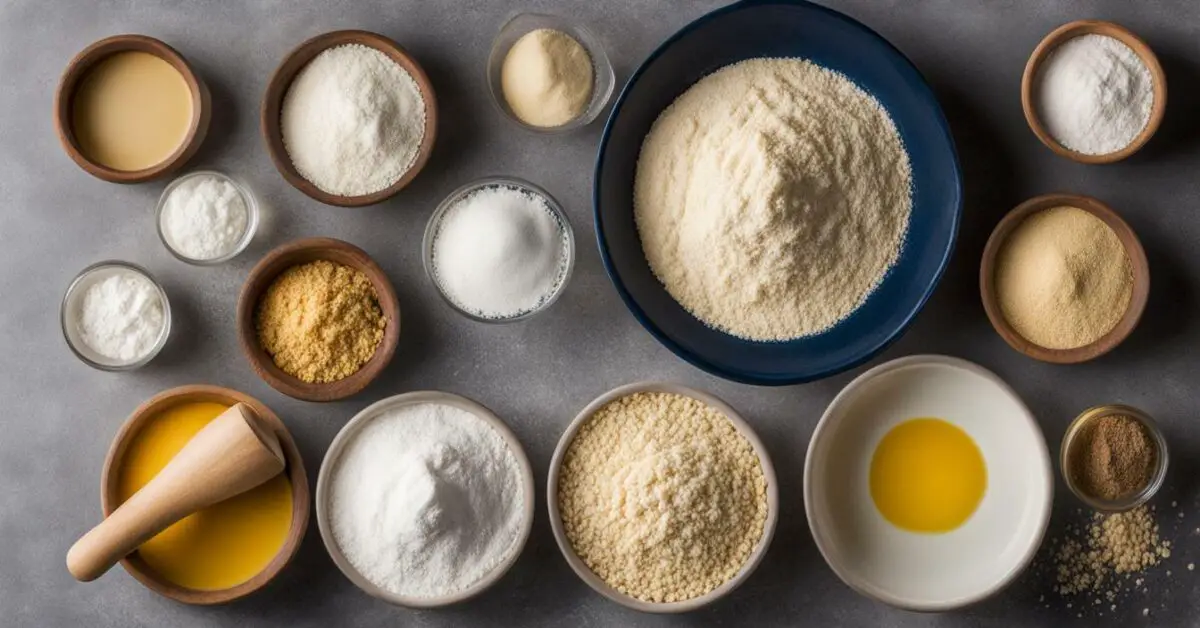
This post may contain affiliate links. Please read my disclosure for more information.
When making quiche and you find yourself out of cornstarch, there are several alternatives you can use as a substitute. One option is all-purpose flour, which has about half the thickening power of cornstarch, so you’ll need to use twice as much. Arrowroot powder is another good alternative, with the same thickening power as cornstarch and the ability to create a glossy sauce. Potato starch can also be used, with equal measurements to cornstarch. Rice flour is a colorless option that can be used in clear liquids, requiring twice the amount of cornstarch. Tapioca starch, although not as strong a thickener, can be used with twice the amount of cornstarch. Other alternatives include ground flaxseeds, glucomannan, psyllium husk, xanthan gum, and guar gum, each with their own unique properties and measurements. Additionally, there are other techniques you can employ to thicken your quiche, such as simmering, blending vegetables, or adding sour cream or Greek yogurt.
Key Takeaways:
- All-purpose flour can be used as a substitute for cornstarch, but you’ll need to use twice the amount due to its lower thickening power.
- Arrowroot powder is a good alternative to cornstarch, offering the same thickening power and the ability to create a glossy sauce.
- Potato starch can be used in equal measurements to cornstarch as a substitute in quiche.
- Rice flour is a colorless option that can be used in clear liquids, requiring twice the amount compared to cornstarch.
- Tapioca starch is not as strong a thickener, but it can be used with twice the amount of cornstarch.
All-Purpose Flour
One option for substituting cornstarch in quiche is all-purpose flour, which has about half the thickening power. This means that you will need to use twice as much all-purpose flour compared to cornstarch to achieve the same effect.
To use all-purpose flour as a thickening agent in your quiche, start by measuring the amount of cornstarch called for in your recipe. Then, double that amount and replace it with all-purpose flour. For example, if your recipe calls for 1 tablespoon of cornstarch, you will need to use 2 tablespoons of all-purpose flour.
When adding all-purpose flour to your quiche mixture, it’s important to remember that it can leave a slightly floury taste if not cooked properly. To prevent this, make sure to cook your quiche thoroughly to allow the flour to fully incorporate and blend with the other ingredients.
| Cornstarch | All-Purpose Flour |
|---|---|
| 1 tablespoon | 2 tablespoons |
| 2 tablespoons | 4 tablespoons |
| 1/4 cup | 1/2 cup |
Summary:
- All-purpose flour is a suitable substitute for cornstarch in quiche.
- It has about half the thickening power, so you’ll need to use twice as much.
- Cook your quiche thoroughly to prevent any floury taste.
Arrowroot Powder: A Great Substitute for Cornstarch in Quiche
When making quiche and you find yourself out of cornstarch, there are several alternatives you can use as a substitute. One option is all-purpose flour, which has about half the thickening power of cornstarch, so you’ll need to use twice as much. Another good alternative for cornstarch in quiche is arrowroot powder, which has the same thickening power and can create a glossy sauce.
Arrowroot powder is a fine white powder extracted from the root of the arrowroot plant. It is a natural and gluten-free thickener that works well in a variety of dishes, including quiche. When used as a substitute for cornstarch, arrowroot powder produces similar results, providing a silky smooth texture to your quiche filling. The general rule of thumb is to use an equal amount of arrowroot powder as you would cornstarch.
Table: Comparison of Cornstarch and Arrowroot Powder
| Cornstarch | Arrowroot Powder |
|---|---|
| Thickening Power | Same as cornstarch |
| Texture | Creates a glossy sauce |
| Measurement | Equal to cornstarch |
| Allergen | Gluten-free |
Not only does arrowroot powder offer a suitable replacement for cornstarch in quiche, but it also has other benefits. It is easily digestible, making it a great option for those with sensitive stomachs. Additionally, arrowroot powder works well with acidic ingredients without breaking down, making it ideal for quiche recipes that include tomatoes or other acidic components.
Next time you’re making quiche and realize you’re out of cornstarch, don’t worry. Give arrowroot powder a try as a substitute, and enjoy the same thickening power and glossy texture it provides. You’ll be pleasantly surprised by the results!
Potato Starch as a Substitute for Cornstarch in Quiche
Potato starch is a versatile alternative to cornstarch when it comes to thickening your quiche. Not only does it provide a similar level of thickening power, but you can also use the same amount of potato starch as you would cornstarch in your recipe.
When using potato starch as a substitute, it is important to note that it performs best when mixed with a small amount of liquid, such as water or stock, before adding it to your quiche filling. This helps to prevent clumping and ensures a smooth and creamy texture.
If you’re worried about the flavor of potato starch overpowering your quiche, rest assured that it is virtually flavorless once cooked. This means that it won’t interfere with the taste of your dish, allowing the other ingredients to shine.
To use potato starch in your quiche recipe, simply substitute it for the same amount of cornstarch called for in the original instructions. This makes it an easy swap for those who have run out of cornstarch or prefer not to use it in their cooking.
Potato Starch vs. Cornstarch: A Comparison
| Potato Starch | Cornstarch |
|---|---|
| Same thickening power | Same thickening power |
| Use the same amount | Use the same amount |
| Creates a smooth and creamy texture | Creates a smooth and creamy texture |
| Flavorless when cooked | Flavorless when cooked |
As you can see, potato starch and cornstarch are very similar in terms of their thickening power and overall performance in quiche. So, the next time you find yourself without cornstarch, feel confident in reaching for potato starch as a reliable substitute.
Rice Flour: A Colorless Alternative for Quiche
For a colorless alternative, you can use rice flour instead of cornstarch in quiche, but you’ll need to use twice as much. Rice flour is a versatile substitute that can be used in clear liquids without altering the color of your dish. While it may require a larger quantity compared to cornstarch, rice flour still provides the thickening power you need to achieve a creamy texture in your quiche.
When using rice flour as a substitute for cornstarch, it’s important to note that the measurements will differ. For example, if a recipe calls for 1 tablespoon of cornstarch, you will need to use 2 tablespoons of rice flour. The additional rice flour ensures the desired consistency without compromising the taste or appearance of your quiche.
It’s also worth mentioning that rice flour is gluten-free, making it an excellent choice for individuals with gluten sensitivities or dietary restrictions. This alternative is widely available in most grocery stores and can be easily incorporated into your favorite quiche recipes.
| Ingredient | Substitution Ratio |
|---|---|
| Cornstarch | 1 tablespoon |
| Rice Flour | 2 tablespoons |
Experimenting with different substitutes allows you to adapt your quiche recipe based on personal preferences or ingredient availability. Whether you choose rice flour or another alternative, knowing the appropriate measurements and properties of each substitute empowers you to create delicious quiche without cornstarch.
Tapioca Starch
Tapioca starch is another option for substituting cornstarch in quiche, but you’ll need to use twice as much. This starch is derived from the cassava root and is known for its ability to provide a light and chewy texture to baked goods. When used as a thickener in quiche, tapioca starch adds a subtle, slightly sweet taste.
One advantage of using tapioca starch as a substitute is that it works well with high heat, making it suitable for quiches that require longer baking times. It also creates a smooth and glossy texture, enhancing the overall appearance of the dish. To achieve the desired consistency, use twice the amount of tapioca starch compared to cornstarch.
Here’s a table summarizing the key points about using tapioca starch as a substitute for cornstarch in quiche:
| Tapioca Starch | Substitute for Cornstarch in Quiche |
|---|---|
| Thickening Power | Not as strong as cornstarch |
| Measurement Ratio | Use twice the amount of cornstarch |
| Taste | Subtly sweet |
| Texture | Light and chewy |
| Appearance | Creates a smooth and glossy texture |
| Suitability | Works well with high heat |
So, if you’re in need of a cornstarch substitute for your quiche, tapioca starch can be a great option. Just remember to adjust the measurements accordingly to achieve the desired thickening effect and enjoy the delightful texture it brings to your dish.
Other Alternatives
In addition to the previously mentioned substitutes, there are other alternatives you can try to replace cornstarch in your quiche. These alternatives can provide different textures and properties to your dish, giving you the freedom to experiment and customize your recipe. Here are some additional options:
- Ground Flaxseeds: Ground flaxseeds can be used as a binding agent and thickener in quiche. They have a nutty flavor and are packed with nutrients like omega-3 fatty acids. To use ground flaxseeds, mix 1 tablespoon with 3 tablespoons of water for each tablespoon of cornstarch called for in the recipe. Allow it to sit for a few minutes to thicken before adding it to your quiche mixture.
- Glucomannan: Glucomannan is a natural thickening agent derived from the root of the konjac plant. It is a soluble fiber that can absorb a significant amount of liquid, resulting in a thick and creamy texture. To use glucomannan as a substitute for cornstarch, sprinkle a small amount into your quiche mixture while whisking continuously. Start with 1/4 teaspoon and adjust as needed to achieve the desired consistency.
- Psyllium Husk: Psyllium husk is a versatile ingredient that can be used as a binding agent and thickener in various recipes, including quiche. It is high in dietary fiber and adds a subtle nutty flavor. To replace cornstarch with psyllium husk, use about 1 tablespoon for every tablespoon of cornstarch. Mix it with a small amount of water to form a gel-like consistency before adding it to your quiche filling.
- Xanthan Gum: Xanthan gum is a popular thickening agent commonly used in gluten-free baking. It is derived from fermented sugars and helps improve the texture and structure of baked goods. To replace cornstarch with xanthan gum, use about 1/2 teaspoon for every tablespoon of cornstarch. Dissolve it in a small amount of liquid before adding it to your quiche mixture.
- Guar Gum: Guar gum is another thickening agent often used in gluten-free cooking and baking. It is derived from the guar bean and helps improve the viscosity and binding properties of various dishes. To substitute cornstarch with guar gum, use about 1/2 teaspoon for every tablespoon of cornstarch. Mix it with a small amount of liquid and allow it to hydrate before incorporating it into your quiche recipe.
These alternatives offer you a range of options to experiment and find the perfect substitute for cornstarch in your quiche. Remember to consider the specific measurements and properties of each alternative to ensure the best results in your culinary creations.
| Substitute | Measurement | Properties |
|---|---|---|
| Ground Flaxseeds | 1 tbsp + 3 tbsp water | Nutty flavor, binding agent |
| Glucomannan | Start with 1/4 tsp, adjust as needed | Natural thickener, creamy texture |
| Psyllium Husk | 1 tbsp | Subtle nutty flavor, binding agent |
| Xanthan Gum | 1/2 tsp | Improves texture, gluten-free |
| Guar Gum | 1/2 tsp | Viscosity, binding properties |
Other Techniques to Thicken Quiche
If you don’t have cornstarch on hand, there are other techniques you can use to thicken your quiche. Simmering is a simple and effective method that involves cooking the quiche mixture over low heat until it reduces and thickens. This allows the flavors to concentrate and gives the quiche a richer texture. Just be sure to stir frequently to prevent the mixture from sticking to the pan.
An alternative technique is to blend vegetables into your quiche mixture. This not only adds texture and thickness but also enhances the flavor profile of your quiche. You can use ingredients like cooked and mashed potatoes, pureed cauliflower, or blended beans to achieve a creamy consistency. Experiment with different vegetables to find the ones that complement your quiche filling the best.
Another option for thickening quiche is to add sour cream or Greek yogurt. These dairy products not only provide a creamy texture but also add a tangy flavor to the quiche. Simply whisk in a dollop of sour cream or Greek yogurt with your other ingredients before baking. The result will be a velvety and indulgent quiche that will delight your taste buds.
| Thickening Technique | Method |
|---|---|
| Simmering | Cook the quiche mixture over low heat until it reduces and thickens, stirring frequently. |
| Blending Vegetables | Add cooked and mashed vegetables or pureed beans to the quiche mixture for added thickness and flavor. |
| Adding Sour Cream or Greek Yogurt | Whisk in a dollop of sour cream or Greek yogurt with the other ingredients for a creamy and tangy quiche. |
As you can see, there are several techniques you can try when you need to thicken your quiche without cornstarch. Whether you opt for simmering, blending vegetables, or adding sour cream or Greek yogurt, each method will contribute its own unique qualities to your quiche. Experiment with these alternatives to find the perfect substitute for cornstarch that suits your taste and dietary preferences.
Conclusion
In conclusion, when you need a substitute for cornstarch in quiche, there are several alternatives that can enhance the flavor and texture of your dish. All-purpose flour is a reliable option, although you’ll need to use twice as much since it has half the thickening power of cornstarch. If you’re looking for a glossy sauce, arrowroot powder is a great choice with equal thickening power to cornstarch. For a simple 1:1 substitution, potato starch works well, or you can opt for rice flour, which is colorless and ideal for clear liquids.
Tapioca starch is another alternative that can be used in double the amount of cornstarch, while still providing some thickening properties. If you’re feeling adventurous, you can explore other alternatives such as ground flaxseeds, glucomannan, psyllium husk, xanthan gum, and guar gum, each with their own unique properties and measurements.
However, if you don’t have any of these alternatives on hand, there are other techniques you can use to thicken your quiche. Simmering the mixture can help reduce excess liquid and thicken the filling. Additionally, blending vegetables can add natural thickness and flavor. Another option is to incorporate sour cream or Greek yogurt, which can add creaminess and help thicken the quiche.
With these substitutes and techniques at your disposal, you can confidently experiment and create delicious quiches even when cornstarch is not available. Enjoy the process of exploring new flavors and textures while still achieving a satisfying outcome!
FAQ
What are the best substitutes for cornstarch in quiche?
Some of the best substitutes for cornstarch in quiche include all-purpose flour, arrowroot powder, potato starch, rice flour, tapioca starch, ground flaxseeds, glucomannan, psyllium husk, xanthan gum, and guar gum.
How much all-purpose flour should I use as a substitute for cornstarch in quiche?
All-purpose flour has about half the thickening power of cornstarch, so you’ll need to use twice as much as the cornstarch measurement in your quiche recipe.
What is the thickening power of arrowroot powder?
Arrowroot powder has the same thickening power as cornstarch and can create a glossy sauce in your quiche.
Can I use potato starch instead of cornstarch in quiche?
Yes, potato starch can be used as a substitute for cornstarch in quiche, with equal measurements to cornstarch.
How much rice flour should I use as a substitute for cornstarch in quiche?
Rice flour can be used in clear liquids and requires twice the amount of cornstarch in your quiche recipe.
Is tapioca starch a good alternative to cornstarch in quiche?
Tapioca starch is a viable substitute for cornstarch in quiche, although it is not as strong a thickener. You’ll need to use twice the amount of cornstarch in your recipe.
What are some other alternatives for cornstarch in quiche?
Ground flaxseeds, glucomannan, psyllium husk, xanthan gum, and guar gum are other alternatives for cornstarch in quiche, each with their own unique properties and measurements.
Are there any techniques I can use to thicken my quiche without cornstarch?
Yes, there are other techniques you can employ to thicken your quiche when cornstarch is not available. Simmering, blending vegetables, and adding sour cream or Greek yogurt can be effective methods.


